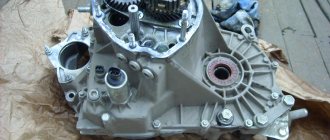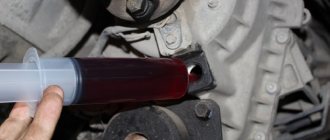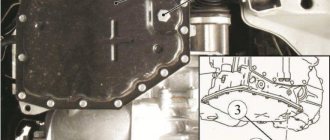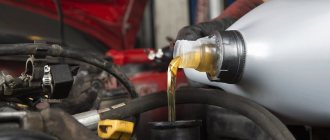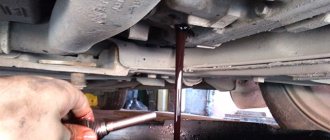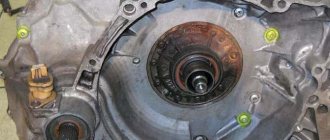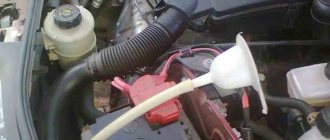It is best to change the oil in the gearbox on a VAZ-2107 regularly, without waiting for signs of deterioration in performance to appear. Problems that arise most often indicate that the service life of the lubricant has already expired. Such malfunctions may be:
- poor clutch performance;
- extraneous squeaks and knocks from the gearbox;
- problems with gear shifting.
When changing the oil in a VAZ-2107 gearbox, you need to take into account the amount of fluid required.
The lubricant loses its properties faster during active driving and during prolonged use in severe frost conditions. Untimely replacement of transmission fluid can lead to failure of the VAZ-2107 gearbox.
Checking the oil level
Every few months, before or after long trips, it is recommended to check the gearbox oil level. To check the level, you need to use an inspection hole or a lift. Using a seventeen wrench, unscrew the drain plug. Using a screwdriver or other object, we check the controlled volume of lubricant. It should reach the bottom edge. If the level is low, the required amount is added with a syringe. If there is a strong drop, it is important to check the gearbox shaft seals. Oil sweating is allowed. The appearance of drops on the box housing indicates damage to the gaskets or loosening of the fastening nuts.
VAZ 2101 gearbox malfunctions
The VAZ 2101 gearbox is a reliable unit, but since many cars of this model currently have quite a lot of mileage, one should not be surprised at the occurrence of one or another breakdown. Based on this, we should consider the most common malfunctions of “penny” gearboxes.
Gears won't turn on
One of the malfunctions that can appear on the VAZ 2101 gearbox is when the gears do not engage. The problem may be due to several factors. On classic Zhiguli models, gears are engaged hydraulically, that is, when the pedal is pressed, the fluid pushes the piston of the working cylinder, which leads to the movement of the clutch fork and retraction of the disc. If a cylinder leak occurs, the gears will not engage because the fork simply will not move.
In this case, it is necessary to check the fluid level in the reservoir under the hood and inspect the system for leaks.
A rather rare case, but still occurring, is the failure of the clutch fork itself: the part may break. A possible reason is the low quality of the product. To fix the problem you will have to replace the plug. Do not forget also about the release bearing, which, by pressing the clutch petals, disconnects the disc from the flywheel and basket. If a bearing fails, engaging gears becomes problematic. In addition, characteristic sounds (whistle, crunching) may be present.
In addition to the reasons listed, the problem with gear shifting may be related to the gearbox synchronizers. If gears cannot be engaged with the engine running or shifting is difficult, then the likely cause is synchronizers. If these gears wear out, turning on may be completely impossible. To fix the problem, mandatory replacement of parts will be required. In addition, nuances in the functioning of gears may be due to wear of the clutch mechanism (basket or disc).
Knocks out the transmission
On a VAZ 2101, gears can sometimes switch off spontaneously, that is, they are knocked out, for which there are a number of justifications. One of the reasons is a loose flange nut on the secondary shaft of the gearbox. The problem manifests itself as a result of harsh operation of the gearbox, for example, when starting abruptly with quickly releasing the clutch pedal, dynamic driving, or not fully disengaging the clutch. As a result of such driving, the wear of almost all elements of the box accelerates: synchronizer rings, gear teeth, crackers, retaining springs, bearings.
After the flange nut is released, free play (backlash) appears, which leads to shock engagement of the gears. As a result, both forward and reverse gears spontaneously disengage. In addition, the steps can be knocked out when the forks responsible for shifting gears wear out. This also includes the production of seats for rods, as well as springs and balls.
Noise, crunching in the box
The occurrence of certain nuances with the VAZ 2101 gearbox indicates a malfunction of the mechanism elements (breakage or wear). Depending on the nature of the malfunction, the box may make noise, and make different noises. The main causes of noise include:
- low oil level;
- bearing wear;
- large output of the main gear.
As a lubricating fluid, the VAZ 2101 gearbox housing contains transmission oil, which is designed to lubricate parts and reduce friction. If noise appears during vehicle operation, this may indicate a decrease in the level of lubricant or a deterioration in its anti-friction properties. A drop in level may be the cause of oil seal failure, which cannot be overlooked by the box housing - it will be covered in oil. If noise occurs due to wear in the bearings or the main pair, it will be necessary to disassemble the box and replace the failed parts.
In addition to noise, a crunching noise may appear on the “penny” gearbox over time, for example, when shifting gears from second to first. The probable cause is failure of the synchronizer. This problem usually manifests itself during frequent changes from upshift to downshift at high speed, while the manufacturer recommends performing similar actions at low speed. The way out of this situation is to disassemble the box and replace the synchronizer of the corresponding gear. If a crunching noise occurs during any shifting, the cause is wear on the clutch basket, which leads to incomplete gear engagement and the appearance of this problem.
Which oil to choose
You should know what kind of oil to pour into the VAZ-2107 box. Only special gear oils of the following groups need to be poured into the classic box: GL-4 and GL-5. Lubricant viscosity can be: SAE 75w-85, SAE 75w-90, SAE 80w-85. The advantage of mineral lubricants is their low price. In severe frosts, such oil begins to thicken and does not fully perform its functions. Synthetic gear oil better protects gearbox mechanisms at ultra-low temperatures (down to -40 degrees).
About types of transmission oils
Modern industry offers a wide range of different fluids, and the quality of the gearbox depends on the correct choice. At the moment, there are three types of oils: synthetic, semi-synthetic and mineral water . Each of these mixtures has its own set of characteristics and properties.
Mineral transmission is the most budget option. This oil has good lubricating properties, but has a significant drawback. In extreme cold conditions it freezes very quickly .
Unlike mineral water, synthetics and semi-synthetics have a higher price. In addition, such oils thicken less at low temperatures and are excellent for use in severe frosts. Synthetic and semi-synthetic oils also differ from each other. The consistency of semi-synthetic liquid is thicker than synthetics. It is great for cars with high mileage. Synthetic oil is better used for new gearboxes, as it is thinner and can leak if there are even the smallest defects in the seals.
When choosing products, first of all, you need to pay attention to viscosity. SAE index indicates .
SAE standards, transmission fluids are divided into the following categories:
- Summer oil (marking consists of numbers only).
- Winter mixture (in its designation it has the English letter W - winter ).
- All-season liquid. The marking of such a lubricant consists of two numbers, which are separated by the letter W. This oil can be used all year round.
Synthetic and semi-synthetic oils that have the following viscosity classes are suitable for the gearbox:
- SAE80W85 is an all-season liquid with a temperature range from -35 °C to +35 °C.
- SAE75W90 is a mixture used at any time of the year with a recommended temperature range from -40 °C to +35 °C.
- SAE75W85 is a multi-season oil, designed for work within the range of -40 °C...+45 °C.
In addition, when choosing transmission fluid, you can come across the API . It implies the systematization of lubricants according to their quality, application and performance characteristics. There are 7 groups in total, but only two are the most popular.
the VAZ 2107 gearbox, the manufacturer recommends the following groups of transmission fluids:
- GL-4. This oil is characterized by the presence of a large number of additives. It is used for gearboxes that operate in high gears at low torques and in low gears at high torques.
- GL-5. This fluid was developed for hypoid gears with high axle displacement. It has proven itself well when working in harsh conditions.
What is needed for replacement
You can replace the transmission fluid yourself. With proper preparation and a little skill, the entire procedure will take about an hour. You must first purchase the required type of lubricant and prepare the following tools and accessories:
- drain container for waste liquid with a volume of about two liters;
- a special syringe or homemade device (bottle, tube) for filling transmission oil;
- a seventeen-size wrench and a twelve-size hexagon;
- protective gloves and rags for cleaning surfaces.
Instructions for changing the oil in the VAZ-2117 gearbox
It is best to change the oil in the gearbox on a VAZ-2107 regularly, without waiting for signs of deterioration in performance to appear. Problems that arise most often indicate that the service life of the lubricant has already expired. Such malfunctions may be:
- poor clutch performance;
- extraneous squeaks and knocks from the gearbox;
- problems with gear shifting.
The lubricant loses its properties faster during active driving and during prolonged use in severe frost conditions. Untimely replacement of transmission fluid can lead to failure of the VAZ-2107 gearbox.
How to change: main stages of the process
Before performing the lubricant change procedure, you need to warm up the car a little (10 - 15 minutes). Changing the oil in the VAZ-2107 gearbox is carried out in the inspection pit:
- Using a 17 key, unscrew the filler plug.
- Use a hexagon to unscrew the drain plug.
- Completely drain the used oil into the prepared container. It is important to remember that the liquid remains hot for some time.
- We return the drain plug to its place.
- We fill in new lubricant using a syringe or a homemade device.
- Pour in new fluid until it starts pouring out of the filler hole.
- We tighten the filler plug.
Many auto mechanics recommend pouring a little more transmission fluid into a five-speed gearbox (above the level) so that the fifth gear never remains dry. Otherwise it may fail. This procedure can be done by slightly lifting the car from the side of the filler plug with a jack.
Equipment and tools
What equipment will you need to change the oil:
- A container for draining used oil - for example, an old bucket or basin.
- 12mm hex wrench.
- Socket wrench 17 or socket 17.
- Protective rubber gloves to avoid getting burned.
- Oil filter puller - it’s not always possible to unscrew it by hand.
- Syringe for filling oil.
- Watering can for pouring oil.
That, in fact, is all that is required.
Sequence of work
To do this you need to complete the following steps:
- First of all, the oil must be warmed to operating temperature. This can be done by driving a few kilometers.
- The car needs to be driven onto an overpass or inspection hole and put on the handbrake.
- Find the drain and fill holes.
- Clean the transmission housing and oil fill and drain plugs using a wire brush and then a rag.
- Place a container under the drain hole to drain the used oil.
- Using a hex wrench, unscrew the drain plug.
- Drain the waste. You should be careful at this point, as the oil is very hot.
- Clean the drain plug from dirt and screw it into place.
- Carefully inspect the drained lubricant. If there is metal dust in it, then the gearbox requires repair.
- Insert the grease gun into the oil filler neck and fill in the required amount of oil. Typically, liquid is added until it begins to flow out of the filler hole.
- Screw the oil filler cap into place. The oil change is complete.
The same fluid is poured into the gearbox and rear axle gearbox. Therefore, it is better to change the oil in these units at the same time.
For those cars whose boxes have a dipstick for checking the oil level, the steps are as follows:
- Find the drain cover on the gearbox.
- Remove the rubber cap from the gearbox and clean it. At the same time, clean the breather, then return the cap to its place.
- Place a container for waste fluid under the crankcase and unscrew the drain cap.
- Wait until the oil drains completely.
- Screw the drain plug into place.
- Pull out the dipstick showing the oil level in the gearbox.
- Insert a funnel where the dipstick was and add fresh fluid.
- While pouring lubricant, you need to monitor the level using a dipstick.
- The fluid level should be midway between the minimum and maximum marks.

